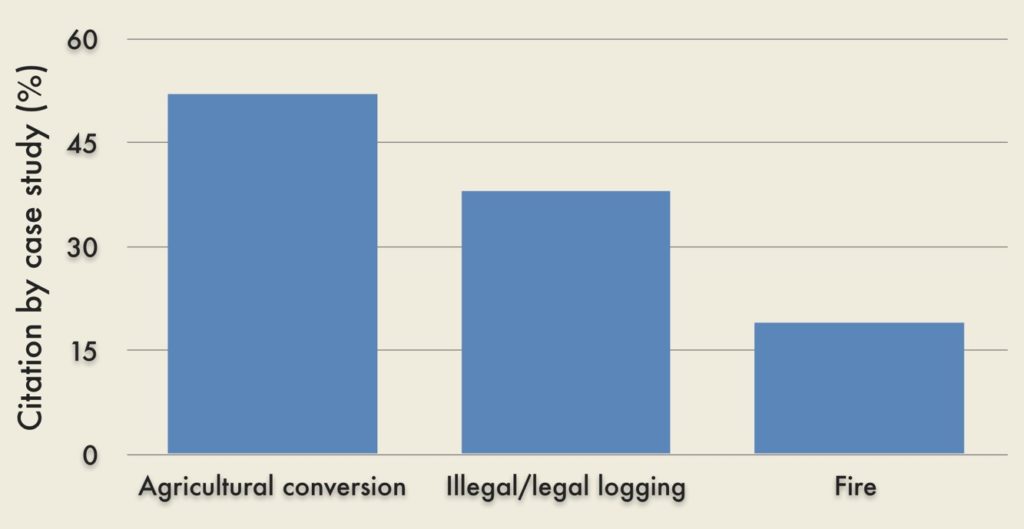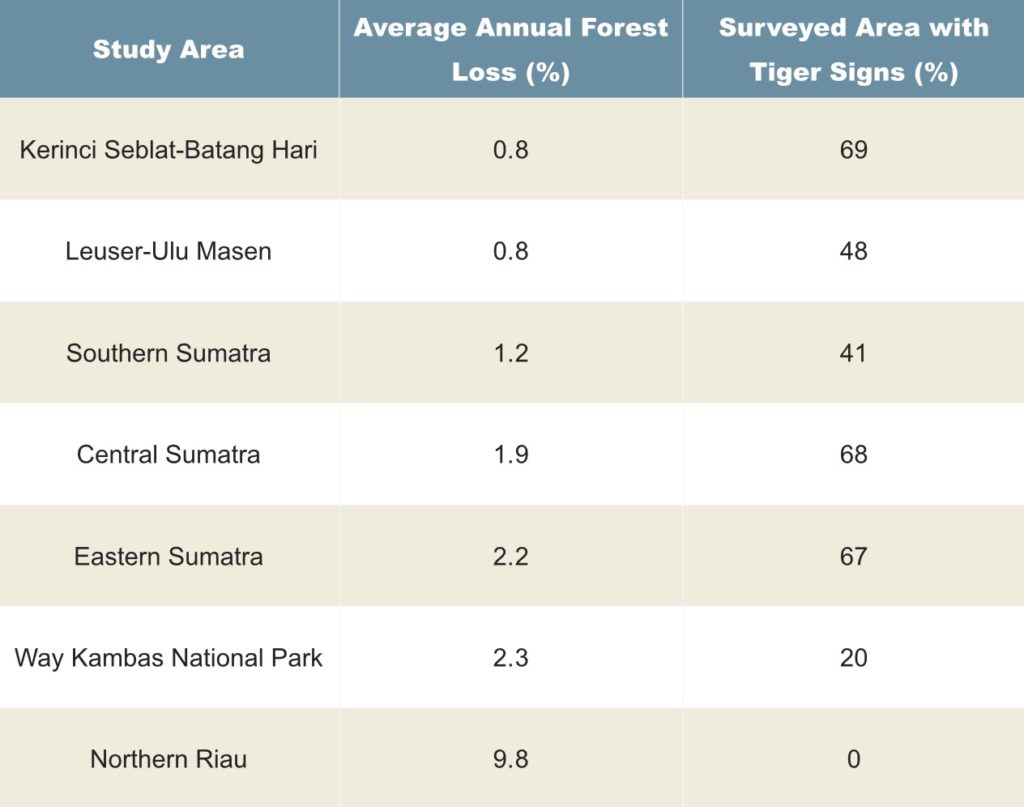Population Ecology
5.5 Tigers- Naked and Alone in the Disappearing Sumatran Forests
Lydia F. Bednarski
The Sumatran tiger is struggling to survive on the Indonesian islands. Deforestation caused by human activity is destroying the rainforest habitat in which the tigers live. As their habitat continues to dwindle, human-tiger conflicts increase. Is there a way to save the Sumatran tiger before they become extinct?

Photograph by Roger Smith, 2012. CC BY-NC 2.0.
As a species, the tiger has become a “poster child” for conservation of endangered species. Three of the eight tiger subspecies are extinct due to human activity.1 In Indonesia, the Sumatran tiger is the only remaining subspecies after two other subspecies went extinct in the mid-twentieth century.2 The Sumatran tiger (Panthera tigris sumatrae) is extremely rare (Figure 1 and 2). Researchers are searching for ways to revive the population, but the tiger’s elusiveness makes them difficult to study. However, new mapping methods allow biologists to study the tigers in their disappearing habitat as well as their interactions with humans. Researchers have created a mapping system using motion-activated cameras deployed in grids around Sumatran national parks.1 Expectedly, it was discovered that tigers preferred denser forests as opposed to locations in which deforestation has occurred.3 In Riau, Sumatra, deforestation continues at a rate of 9.8% per year.4 The Sumatran tiger’s shrinking habitat has forced them towards human societies where they occasionally prey on livestock, and in some instances, attack people. Sixteen tigers were killed in a five year period due to encounters with human societies, a grave toll for a population of only a few hundred.2 These types of deaths, coupled with their increasing habitat loss, are enough to cause extinction for the Sumatran tiger in the near future. However, if Sumatra’s National Tiger Recovery Plan is successful, there may be double the number of tigers by the year 2022.4 The National Tiger Recovery Plan was enacted in July 2010 and its long term goal is to “double the number of wild tigers by securing source populations within the largest and most viable Sumatran tiger conservation landscapes by maintaining connectivity between these protected populations”.5

The Sumatran tiger is only found on the island of Sumatra in western Indonesia. Its range is highly fragmented due to human encroachment and deforestation.
Modified from ToB, 2011. Public Domain.
Deforestation is the primary cause behind the Sumatran tiger’s dwindling numbers (Figure 3). Since 1993, Sumatra has lost 48% of its forest cover.6 Not only is deforestation harmful to tigers, it also accounts for 20% of the world’s greenhouse gas emissions.7 Similarly, 71% of tiger habitat in Asia is currently undergoing deforestation.8 Rainforests are being cut down to create land for agriculture and the fell trees are used for fuelwood and timber-use products. In Sumatra, most of the logging is occurring in the lower elevation forests, which support high densities of Indonesian wildlife, including the Sumatran tiger.4 Many of these forests are getting logged because there is little to no protection for them9 (Figure 4). As a result, roads are built through the Sumatran forest. The roads bring high levels of human activity into the wilderness and reduce the tigers’ habitat to smaller, less viable patches.10

The conversion of land for agriculture is the leading cause of deforestation in Indonesia. Causes of deforestation were determined through a case study analysis.
Courtesy of P. Mondal and H. Nagendra, 2011. Public Domain.

Data from Wibisono et al., 2011.
Presently, the majority of wild Sumatran tigers are located in 12 Tiger Conservation Landscapes (TCLs) covering approximately 88,000 km2.10 Tiger conservation is difficult because there are few options to monitor the tigers at Level 1 TCLs, and these options are not always accurate.1 Infrared cameras provide the most exact locations of tigers and help biologists monitor the populations. When biologists conduct population counts, they deploy infrared cameras around the Sumatran rainforest. The cameras are checked every two weeks and are moved accordingly if tigers are found in other places.3 A camera snaps photos for 20 seconds whenever a moving tiger is detected within range11 (Figure 5). When tigers are captured on camera, biologists classify the animal by its size and stripe pattern. Tigers were often identified through these pictures. From these pictures, a map of Sumatra’s tiger densities could be made. It was found that tigers preferred primary forests, which were less accessible than degraded forest sites found near logging roads. Only 29% of the tiger habitat patches are protected.10 Distressingly, all the study sites in one experiment showed evidence of human disturbance including footprints, litter, and snare traps set for tiger prey.1

Photograph used by permission of Jeremy Holden, 2006.
As the Sumatran tiger habitat decreases, human-tiger conflicts become more likely. Many Sumatrans are hostile towards tigers because they prey on livestock, attack humans, and cause insecurity within communities.2 A negative local attitude towards tigers creates problems for conservationists, since community members will oppose protected tiger habitats.2 During the years 1978-1997, tigers in Sumatra killed 146 people and wounded another 30 people.2 A total of 870 livestock deaths by tigers were also reported during this time.2 In response to these attacks, people illegally killed tigers, which negatively impacted the already small population. Because of the illegality of these killings, many tiger deaths caused by humans are not reported.2 However, when Sumatran forest rangers began distributing compensation for human victims in 2003, reports more than doubled in 2004.
Kerinci Seblat National Park (KSNP) is a region of Sumatra where human-tiger conflicts are common. It is the largest protected area in Indonesia and one of the most important tiger habitats in the world.2 Many people live in close proximity to KSNP, and therefore, close to tigers. Around 1.5 million people live in hundreds of villages situated around KSNP’s 2,600 km boundary area.2 The livestock owned by these villagers are left unsupervised to graze in open areas close to the edge of KSNP, creating easy prey for tigers.2 Biologists are working with these villagers to move tigers away from the communities around KSNP. Disruptive stimuli such as light, audio, and chemical repellents have been used to scare tigers and their prey away from human settlements.2 Despite these conflicts and losses, many people in Indonesia still see tigers as religious spirits, and often dedicate special ceremonies to them.2
The National Tiger Recovery Program was issued to implement a better protection plan for the Sumatran tiger in Indonesia.5 The priorities of the recovery program were to create a specialized tiger law enforcement team, a management system, and a legal basis to have better reign over the endangered cats.5 The conservation team also wants to create tiger conservation funds to ensure sustainable funding for future conservation projects.5 It was estimated in 2010 that the total cost of fully protecting tiger natural habitat was 82 million dollars.12
The Sumatran tiger is one of the most endangered mammals left on Earth. Deforestation of their rainforest habitat has driven the tigers towards human communities. Attacks on humans and livestock have created tension and hostility between villages and Sumatran tigers. Although the tiger seems like a threat to human settlements, it is vital to the greater Sumatran ecosystem. The Ministry of Forestry of Indonesia created The National Tiger Recovery Plan in 2010, which is the government’s response to the decreasing tiger populations in Sumatra. Although natural causes such as forest fires or erosion do cause some habitat loss, it is imperative that the Sumatran government limits deforestation due to human activity. The National Tiger Recovery Plan is Sumatra’s best defense to prevent the extinction of another tiger species.
References
- Linkie, M., et al. (2006). Assessing the viability of tiger subpopulations in a fragmented landscape. Journal of Applied Ecology, 43:576-586
- Nugraha, R.T. & Sugardjito, J. (2009). Assessment and management options of human-tiger conflicts in Kerinci Seblat National Park, Sumatra, Indonesia. Mammal Study, 34:141-154
- Linkie, M., et al. (2008). Conserving tigers Panthera tigris in selectively logged Sumatran forests. Biological Conservation, 141:2410-2415
- Wibisono, H.T., et al. (2011). Population status of a cryptic top predator: An island-wide assessment of tigers in Sumatran rainforests. PLoS ONE. 6:11
- Ministry of Forestry Republic of Indonesia. (2010). National Tiger Recovery Program INDONESIA. [PowerPoint Slides].
- Kanter, James. (2008 October 9). Agreement Reached to Save Sumatran Forests. The New York Times.
- Gelling, Peter. (2007 December 6). Forest loss in Sumatra Becomes a Global Issue. The New York Times, pp A14.
- Mondal, P & Nagendra, H. (2011). Trends in Forest Dynamics in Tiger Landscapes Across Asia. Environmental Management, 48:781-794
- Sunarto, et al. (2013). Threatened Predator on the Equator: multi-point abundance estimates of the tiger Panthera tigris in central Sumatra. Oryx, 47:211-220
- Wibisono, H.T. & Pusparini, W. (2010). Sumatran tiger (Panthera tigris sumatrae): A review of conservation status. Integrative Zoology, 5:313-323
- Goodman, David J. (2011 May 9). Cameras Capture Endangered Tigers in Sumatra Forest. The New York Times.
- Guynup, Sharon. (2014 January 13). Three Thousand Wild Tigers. National Geographic.
- Smith, Roger. (2012). [Photograph of an adult Sumatran tiger]. Retrieved from FlickrCommons. CC BY-NC 2.0.
- ToB. (2011). [Distribution Map of Panthera tigris sumatrae]. Retrieved from Wikimedia Commons. Public Domain. Modifications: Cropped and added key.
- Holden, Jeremy. (2006). [Photograph of a wild Sumatran tiger caught by a motion sensor wildlife camera]. Retrieved from Flickr. © Jeremy Holden/FFI. All Rights Reserves.
